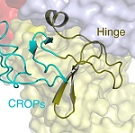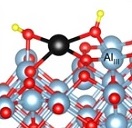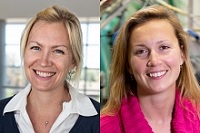Vol. 20, No. 2 - August 2019
View the Archives

SSRL/LCLS Users’ Meeting – September 24-27, 2019Our Annual SSRL/LCLS Users' Meeting is approaching fast. The September 26 plenary sessions will include a welcome from SLAC Director Chi-Chang Kao, an update from DOE BES, facility updates and a town hall discussion with LCLS and SSRL Directors Mike Dunne and Paul McIntyre, invited talks from Stosh Kozimor (LANL) and Philippe Wernet (Helmholtz-Zentrum Berlin), award presentation/talks and a poster session/reception. Workshop topics on September 24, 25 and 27 include:
September 18 is the deadline for online registration and poster abstract submission. Promote your poster at the Poster Blitz and compete for Joe Wong Outstanding Poster Awards. More details are available at the Meeting website. Science Highlight Structure of the Full-length Clostridium difficile Toxin B – Contact: Rongsheng Jin (UC Irvine) The bacterium Clostridium difficile (often called C. diff) can cause severe intestinal infections, responsible for about 500,000 cases and 29,000 deaths in the United States per year. While infections are more often found in ill and elderly people, infection rates are increasing in young and healthy people. The bacterium makes and secretes two related toxins, TcdA and TcdB. Understanding the structure of these molecules is a critical step to developing treatment. Unfortunately, since these toxin proteins are huge and flexible, scientists have been unable to determine the entire molecular structures until now. Read more... SSRL-Related NewsHow the Catalytic Converters in Cars Go Bad and Why it Matters Excerpt from August 12, 2019 Article in Stanford Engineering Magazine by Andrew Myers  Modern cars rely on catalytic converters to remove carbon monoxide, hydrocarbons and other harmful chemicals from exhaust emissions. To do so they rely on costly metals that have special chemical properties that diminish in effectiveness over time. Assistant professor Matteo Cargnello and doctoral candidate Emmett Goodman recently led a team that has proposed a new way to reduce the cost and extend the lifespan of these materials, solving a problem that has vexed automotive engineers for years. In the process, Cargnello and colleagues have done something remarkable: made a breakthrough in a mature field where change comes slowly, if at all. Read more... See paper published August 12, 2019 in Nature Catalysis AwardsArianna Gleason and Diana Gamzina Receive DOE Early Career Research Grants Excerpt from August 1, 2019 SLAC News Article by Ali Sundermier and Manuel Gnida
SLAC staff scientists Arianna Gleason and Diana Gamzina will receive prestigious Early Career Research Program awards for studies in fusion energy and the development of next-generation radiofrequency (RF) technology. They are among 73 recipients selected from a large pool of university and national laboratory applicants, the DOE Office of Science announced today. Each will receive $500,000 per year for five years in support of their work. Using the laser capabilities at the LCLS Gleason will investigate extreme states of matter and how they might be harnessed for fusion energy, which one day could help address the world’s energy needs. Gamzina will study how materials behave when exposed to RF fields, which will lead to the development of improved materials for particle accelerators used in cancer treatments, novel RF sources for communication systems and more. In a first step, she will use a new, unique RF-pump x-ray probe instrument at SSRL to look at microstructural changes in materials hit by RF pulses. Read more... Events
AnnouncementsThe DOE Office of Science Graduate Student Research (SCGSR) Program is Now Accepting Applications The Department of Energy’s (DOE) Office of Science Graduate Student Research (SCGSR) program is now accepting applications for the 2019 Solicitation 2 through Thursday, November 14, 2019. There are four new “convergence” research topical areas which are emerging areas and priorities for research that crosses disciplines. The BES and convergence topics can be found at the Office of Science Priority Research Areas for SCGSR Program site. The SCGSR program supports supplemental awards to outstanding U.S. graduate students to conduct part of their graduate thesis research at a DOE national laboratory/facility in collaboration with a DOE laboratory scientist for a period of 3 to 12 consecutive months—with the goal of preparing graduate students for scientific and technical careers critically important to the DOE Office of Science mission. Detailed information about the program, including eligibility requirements and access to the online application system, can be found at the SCGSR website. Update Your Bookmarks - WWW-SSRL for Access to SSRL Website Are you using ssrl.slac.stanford.edu to access SSRL's web, or do you have bookmarks with this URL? Effective September 2019 you will only be able to access general SSRL web resources with www-ssrl.slac.stanford.edu URLs. We will be unable to provide automatic redirection - attempted connections will just fail. Please start using www-ssrl.slac.stanford.edu addresses now. This change does not affect bookmarks and links to userportal.slac.stanford.edu. User Research AdministrationBeam Time Requests
Proposal Deadlines
Submit beam time requests and proposals through the User Portal. _____________________________________________________________________ The Stanford Synchrotron Radiation Lightsource (SSRL) is a third-generation light source producing extremely bright x-rays for basic and applied research. SSRL attracts and supports scientists from around the world who use its state-of-the-art capabilities to make discoveries that benefit society. SSRL, a U.S. DOE Office of Science national user facility, is a Directorate of SLAC National Accelerator Laboratory, operated by Stanford University for the U.S. Department of Energy Office of Science. The SSRL Structural Molecular Biology Program is supported by the DOE Office of Biological and Environmental Research, and by the National Institutes of Health, National Institute of General Medical Sciences. For more information about SSRL science, operations and schedules, visit http://www-ssrl.slac.stanford.edu. To unsubscribe from SSRL Headlines, just send an e-mail to listserv@slac.stanford.edu with "signoff ssrl-headlines" in the body. To subscribe, send an e-mail to listserv@slac.stanford.edu with "subscribe ssrl-headlines" in the body. Questions? Comments? Contact Lisa Dunn
|

